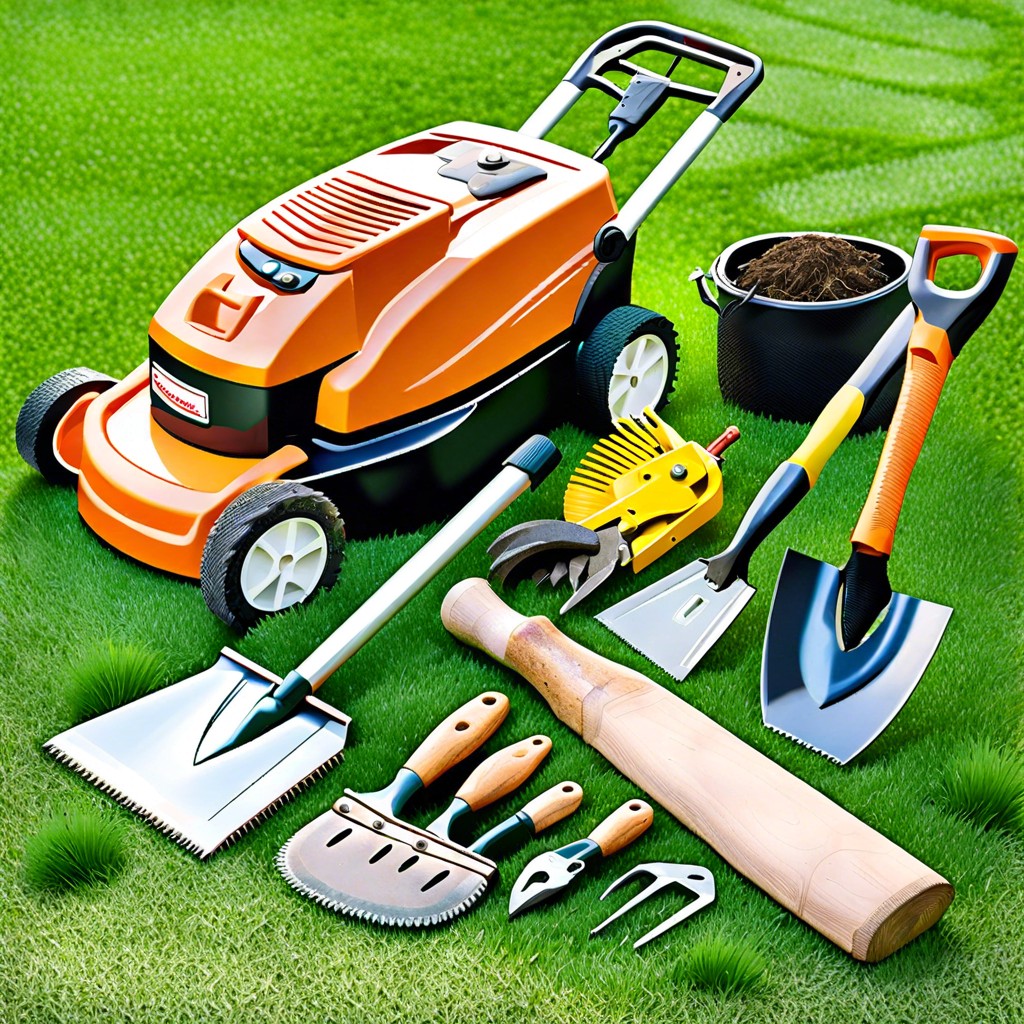Keeping your outdoor space vibrant and healthy can be straightforward with proper landscape maintenance techniques, and this article will guide you through the essential practices to keep your lawn and garden thriving.
Key takeaways:
- Invest in essential tools for effective landscape maintenance.
- Follow proper mowing techniques for healthier lawns.
- Implement optimal tree and shrub trimming practices.
- Utilize integrated pest management in landscaping.
- Embrace eco-friendly landscape solutions for sustainability.
Look Inside:
Essential Tools for Effective Landscape Maintenance

Start strong with a good pair of gloves; they’ll protect your hands from blisters, thorns, and chemicals. Next, you can’t overlook the importance of a solid, sharp spade – ideal for digging and planting. For keeping your edges neat, a sturdy garden edger can save you from the backache of bending and snipping.
A reliable lawnmower is essential for proper grass care and maintaining an even, clean cut. Don’t forget a set of pruning shears for shaping your bushes and trimming small branches. They make the job a breeze and keep your plants healthy by removing dead or overgrown branches.
For larger branches, a lopper or a pruning saw will be more appropriate, giving you the leverage and cutting power needed without straining yourself. Watering wisely is as crucial, so arm yourself with a durable hose and adjustable nozzle to cater to different plant needs without wasting water.
Remember, investing in these tools not only simplifies your gardening tasks but also ensures your landscape remains a beautiful, thriving environment.
Mowing Techniques for Healthier Lawns
To keep your lawn looking its best, consider the height at which you cut the grass. Cutting too short can stress the grass, making it vulnerable to diseases and weeds. A good rule of thumb is to never remove more than one-third of the grass blade in a single mow. This approach encourages deeper root growth, leading to a more resilient lawn.
Remember, the timing of your mowing matters too. Early morning or late afternoon are the best times to mow. Mowing during the heat of the day can cause the grass to go into shock, which might inhibit healthy growth. Also, try to alter your mowing pattern each time. This prevents the grass blades from leaning in one direction and promotes more upright growth.
Lastly, ensure your mower blades are sharp. Dull blades tear the grass rather than cutting it cleanly, which can lead to jagged edges that invite pests and diseases. Regularly sharpened blades make for a cleaner cut and a greener lawn.
Optimal Tree and Shrub Trimming Practices
Trimming your trees and shrubs isn’t just about keeping them looking tidy; it’s crucial for their health and growth. But how do you know when and how to prune correctly?
First, timing is key. Prune flowering shrubs immediately after they bloom to avoid cutting off next year’s buds. For trees, late winter or early spring is best, as sap loss is minimal and the plant is still dormant.
Second, use the right tools. Sharp, clean pruners and loppers make smooth cuts that heal quickly, preventing disease. Always disinfect your tools between cuts, especially if you’re dealing with diseased branches.
Third, know how much to trim. A general rule of thumb is never to remove more than one-third of a plant in a single season. This prevents stress that can stifle growth or even kill the plant.
By following these straightforward steps, you’ll ensure your green friends not only survive but thrive!
Integrated Pest Management in Landscaping
Integrated Pest Management, or IPM, is a sustainable approach aimed at minimizing damage from pests while protecting the environment. This strategy uses a blend of biological, cultural, physical, and chemical methods to control pest populations.
Firstly, understanding the types of pests you are dealing with and the extent of the infestation is crucial. Regular monitoring and proper identification help in deciding whether management is needed and what method is most effective.
Secondly, cultural practices play a huge role. These include selecting pest-resistant plant varieties and adjusting planting times and spacing to reduce pest attractiveness. Maintaining healthy soil and good irrigation practices can also deter pests.
Thirdly, biological control involves using natural predators or parasites to manage pest populations. For instance, introducing ladybugs can help reduce aphid numbers in your garden.
Lastly, chemical controls should be used as a last resort due to their potential impact on non-target species and the environment. If chemicals are necessary, opt for targeted pesticides rather than broad-spectrum ones, and always follow the recommended application rates and timings.
By blending these strategies, IPM promotes long-term, environmentally sound pest management that keeps your landscape healthy and vibrant.
Eco-Friendly Landscape Solutions
Caring for your garden sustainably not only benefits the environment but can also save you time and money in the long run. One effective approach is to install a rainwater harvesting system. This method collects rainwater from your roof, which you can then use to water your plants. It’s a perfect solution for reducing your water bill and conserving this vital resource.
Another great practice is to use native plants in your landscaping. These plants are adapted to your local climate and soil, making them more resistant to pests and diseases while requiring less water and fertilizer. This not only reduces the need for chemical products but also encourages local biodiversity.
Lastly, consider composting kitchen scraps and yard debris to create nutrient-rich compost for your garden. This reduces waste and provides your plants with natural, chemical-free nourishment. Plus, it’s incredibly satisfying to turn leftovers into valuable food for your plants!